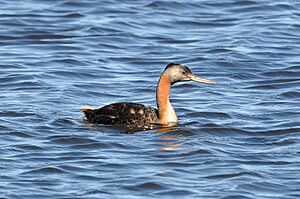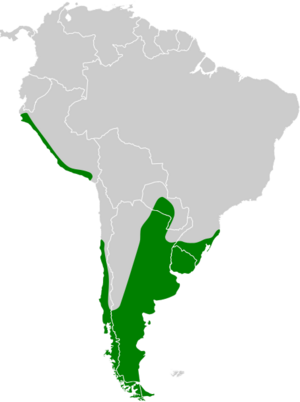Great grebe facts for kids
Quick facts for kids Great grebe |
|
|---|---|
 |
|
| In Rio Grande do Sul, Brazil | |
| Conservation status | |
| Scientific classification | |
| Genus: |
Podiceps
|
| Species: |
major
|
 |
|
| Synonyms | |
|
Podicephorus major (Boddaert 1783) Bochenski 1994 |
|
The great grebe (Podiceps major) is the biggest type of grebe bird in the world! These amazing birds live in different parts of South America. You can find them in northwestern Peru, and also from southeastern Brazil all the way down to Patagonia and central Chile. There's even a special group of them in southern Chile that scientists call a separate subspecies, P. m. navasi.
Contents
Understanding the Great Grebe's Name
Scientists use a system called taxonomy to name and group all living things. This helps them organize and understand different species. The great grebe was first described in 1781 by a French scientist named Georges-Louis Leclerc, Comte de Buffon.
Later, in 1783, a Dutch naturalist named Pieter Boddaert gave it the scientific name Colymbus major. Today, the great grebe is placed in the group (or genus) called Podiceps. This group was created by an English scientist named John Latham in 1787.
Great Grebe Subspecies
There are two main types, or subspecies, of the great grebe:
- P. m. major: This group lives in West Peru, Paraguay, southeastern Brazil, Uruguay, central Chile, and southern Argentina.
- P. m. navasi: This group is found in Southern Chile.
Where Great Grebes Live
Great grebes mostly live in open water areas. You can often spot them on lakes and slow-moving rivers, especially if these areas are surrounded by forests. They also like marshy areas near the coast.
When it's time to breed, they prefer quiet, plant-filled parts of large lakes. After the breeding season, many great grebes move to coastal areas like estuaries and bays. These places often have lots of kelp (a type of seaweed). Sometimes, you might even see them swimming in the open ocean! Some birds stay along the coasts all year round.
These birds are common and found across most of their natural home. A lot of their habitat is still untouched, especially in the southern parts of their range.
What Great Grebes Look Like
The great grebe is a very large bird, much bigger than most other grebes. It looks more like a goose or a cormorant! They can be about 67 to 80 cm (26.5 to 31.5 in) long. They usually weigh around 1,600 grams (3.5 pounds), but some can weigh up to 2 kg (4.4 lb).
Their neck and chest are a reddish-brown color. Their back is dark, almost black, and their belly is whitish. Their head is a dark gray, and they have reddish-brown eyes. Because of its large size and unique colors, it's easy to tell the great grebe apart from other birds.
What Great Grebes Eat
Great grebes mostly eat fish. Sometimes they catch fish that are over 11 cm (4.3 in) long, but usually they eat smaller ones. They might sometimes compete for fish with another bird called the neotropic cormorant. Even though cormorants are smaller, they often catch bigger fish!
Great grebes also eat insects, crustaceans (like shrimp), and mollusks (like snails). In winter, when they are along the coasts, almost half of their diet can be crabs. These birds can also eat the young of other waterbirds, especially coots.
Great Grebe Reproduction
After living in large groups, sometimes with hundreds of birds, great grebes move inland to lay their eggs and raise their young. Most populations lay their eggs between October and January. The further south they are, the later in the season they tend to lay eggs.
In the isolated group in Peru, nesting happens in September and October. They might even have a second group of chicks in January or February. Great grebes are somewhat social when they breed, and sometimes they form small colonies. They usually lay three to five eggs, but sometimes up to six. They can raise two, or possibly more, groups of young at the same time.
Images for kids



